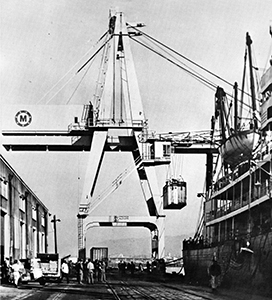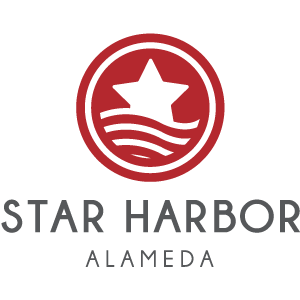
BC Staff Report
Published: April 2014
Arivia question: where was the first land-based container crane installed, heralding a revolution in world commerce? Oakland? Long Beach?
The answer would be Alameda. The crane was installed in 1959 at the Matson Lines Encinal Terminals to speed delivery of pineapples from Hawaii. What didn’t seem significant at the time turned out to be a very big deal. It may not be as big as containerization, but something remarkable is quietly emerging on Alameda’s waterfront again.
The San Francisco Bay waterfront is rapidly gentrifying—Bay Crossings, as an original tenant of the Ferry Building, is part of that trend—with expensive restaurants, ballparks and boutiques crowding out traditional maritime businesses. In stark contrast, Alameda positively welcomes working waterfront businesses with open arms. Some Alameda leaders envision a dedicated zone for such outfits stretching from the High Street Bridge clear around to Ferry Point on the old Naval Air Base, altogether comprising roughly one-third the main island’s waterfront.
Alameda’s contrarian stance is a boon for likely suspects like stolid marine operators Bay Ship & Yacht Company (barge and mid-sized ship repair), Dutra (dike restoration) and Power Engineering (seawall construction). They—along with their hundreds of well-paid blue-collar jobs for welders, painters and other workers—look to be securely in Alameda for decades to come.
Yet Alameda’s is not your father’s waterfront, something you’d conjure up from an old Marlon Brando movie. Alameda’s new working waterfront is a hotbed of distinctive, innovative and thoroughly hip young companies. They include craft breweries, a high-wheel “bonecrusher” bike restorer, a deep-sea submarine maker, an America’s Cup team and much and many more.
All in all, Alameda seems poised to contest with San Francisco’s white-hot Dogpatch neighborhood for the sobriquet of San Francisco Bay’s hippest up-and-coming waterfront spot. The Dogpatch is epicenter of the so-called “maker’s movement,” the source of indigenously crafted goods marketed under the “San Francisco Made” moniker. Like Alameda, it is a heritage maritime district.
Yet in the Dogpatch, gentrification looks to crowd out traditional maritime operations, which are under assault by a slew of regulatory, zoning and neighborhood pressures. The BAE Shipyard there even saw its “Fred Flintstone” yard whistle stolen and held for ransom, with yard management paying in order to obtain its return. Unlike San Francisco, riven with controversy over the skyrocketing cost of living and high unemployment, Alameda’s welcoming policies are yielding a bounty of well-paid blue-collar jobs toiling on green projects like barges to get trucks off highways and sail-powered oceangoing tankers.
Yet Alameda is enjoying the best of both worlds as all manner of new, decidedly terrestrial businesses are also cropping up, cheek by jowl with traditional maritime firms, thereby greatly increasing the quality of life and moving Alameda into a new league of sophistication. The trend mirrors what is happening in places like New York City, where Brooklyn neighborhoods are, in the eyes of many, stealing the march on Manhattan as the preferred places to live.
With this issue, Bay Crossings kicks off monthly highlights of the intriguing companies who have set up shop in Alameda’s working waterfront. We hope this will become a comprehensive guide to interesting and fun places to visit and enjoy along Alameda’s innovative, hip and burgeoning waterfront scene. It’ll be available in print and on our website.

